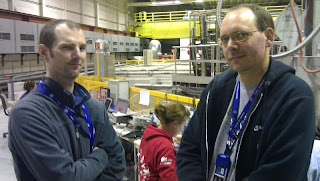libdEdx: I hoped I could announce first official release of the stopping power library before 2011. Unfortunately, there are a few minor problems with the Bethe implementation which Jakob wanted to fix first. It is almost done...
Just to give an idea what's coming up: libdEdx 1.0 will probably be a Linux-only release and we most likely won't include ESTAR tables. Good news are that PSTAR, ASTAR, MSTAR and the ICRU 73 (old and new) tables seem to work. The entire ESTAR ICRU material composition table is supported, so if the user of the library calls a non-standard compound, Braggs additivity rule is automatically applied according to the stochiometric compositions defined by ICRU (see list here).
The Bethe-equation implementation allows the user to override the mean exitation potential for elements. Also, an uninstall target is now provided in the CMake configuration.
If you can't wait for the 1.0 release of libdEdx you may test revision 85 in the SVN repository which is quite close to something functioning.
Enough said about that.
So, regardning the current status of SHIELD-HIT10A: The main developer and maintainer Prof. Nikolaj Sobolevsky from INR Moscow visited us again in Aarhus for a month (a few pictures to be added later). Basically, we discussed the changes from 08 to 10A, the fitting of nuclear models to recently published experimental data and the development framework in general. More importantly, we try to encourage a clearer road map for SHIELD-HIT. In particular, this involves settling on a clear license model and terms of use. This process is ongoing and takes time, but surely we still see SHIELD-HIT filling a gap which neither FLUKA or Geant4 fills when it comes to combining ease-of-use while still having access to the source code. Stay tuned for more on this.
Now for something completely different: Since this blog (<-- beware of the recursion) quite unintentionally has turned more or less into a blog on topics in computing, medical physics and particle therapy, I have invited a fellow blogger Roy Keyes from University of New Mexico (Albuquerque) to contribute. Roy and I have shared many night shifts at CERN running our antiproton experiments.
 |
| Roy Keyes' (to the left) inexhaustible repository of real life anecdotes helped me to stay awake during the long night shifts at CERN October 2011. Thanks, Roy. Everyone, say hi to Roy... |
BTW: You can meet Roy in a little test video I made about the CERN antiproton experiments. Alas, since kdenlive crashes big time in the current version at project loading, I never made it further than the intro and gave up the editing. I'll have to wait until kdenlive is updated in Debian testing repo. But I got looooots of wonderful footage, including details of antiproton production and french speaking technicians fixing dead synchrotrons! :-)
Plenty of plans, only little time, but surely this blog will become much more lively 2011. With these words, I wish you all a happy new year!
Cheers,
Niels
P.S.: Future non-work related blog entries from my side will be published on http://opasnajazona.blogspot.com. (The similarity to a nuclear waste dump is not coincidental.)
